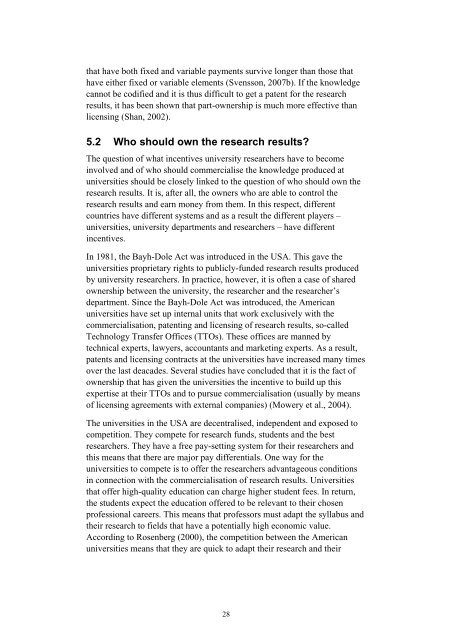Growth through Research and Development - what does ... - Vinnova
Growth through Research and Development - what does ... - Vinnova
Growth through Research and Development - what does ... - Vinnova
You also want an ePaper? Increase the reach of your titles
YUMPU automatically turns print PDFs into web optimized ePapers that Google loves.
that have both fixed <strong>and</strong> variable payments survive longer than those thathave either fixed or variable elements (Svensson, 2007b). If the knowledgecannot be codified <strong>and</strong> it is thus difficult to get a patent for the researchresults, it has been shown that part-ownership is much more effective thanlicensing (Shan, 2002).5.2 Who should own the research results?The question of <strong>what</strong> incentives university researchers have to becomeinvolved <strong>and</strong> of who should commercialise the knowledge produced atuniversities should be closely linked to the question of who should own theresearch results. It is, after all, the owners who are able to control theresearch results <strong>and</strong> earn money from them. In this respect, differentcountries have different systems <strong>and</strong> as a result the different players –universities, university departments <strong>and</strong> researchers – have differentincentives.In 1981, the Bayh-Dole Act was introduced in the USA. This gave theuniversities proprietary rights to publicly-funded research results producedby university researchers. In practice, however, it is often a case of sharedownership between the university, the researcher <strong>and</strong> the researcher’sdepartment. Since the Bayh-Dole Act was introduced, the Americanuniversities have set up internal units that work exclusively with thecommercialisation, patenting <strong>and</strong> licensing of research results, so-calledTechnology Transfer Offices (TTOs). These offices are manned bytechnical experts, lawyers, accountants <strong>and</strong> marketing experts. As a result,patents <strong>and</strong> licensing contracts at the universities have increased many timesover the last deacades. Several studies have concluded that it is the fact ofownership that has given the universities the incentive to build up thisexpertise at their TTOs <strong>and</strong> to pursue commercialisation (usually by meansof licensing agreements with external companies) (Mowery et al., 2004).The universities in the USA are decentralised, independent <strong>and</strong> exposed tocompetition. They compete for research funds, students <strong>and</strong> the bestresearchers. They have a free pay-setting system for their researchers <strong>and</strong>this means that there are major pay differentials. One way for theuniversities to compete is to offer the researchers advantageous conditionsin connection with the commercialisation of research results. Universitiesthat offer high-quality education can charge higher student fees. In return,the students expect the education offered to be relevant to their chosenprofessional careers. This means that professors must adapt the syllabus <strong>and</strong>their research to fields that have a potentially high economic value.According to Rosenberg (2000), the competition between the Americanuniversities means that they are quick to adapt their research <strong>and</strong> their28
















